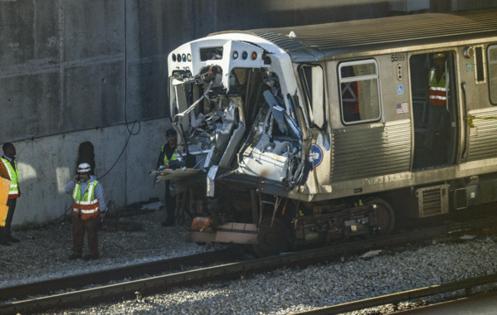Operator in Chicago Transit Authority Yellow Line crash had alcohol in his system, NTSB report finds
Published in News & Features
CHICAGO — The operator of a CTA Yellow Line train that slammed into a snowplow on the tracks last November, injuring more than a dozen people, had alcohol in his system after the crash, a recent federal report found.
A hospital blood test around 11:20 a.m., about an hour after the crash, showed the 47-year-old operator had ethanol in his system at a level of 0.06 grams per deciliter of blood, according to a National Transportation Safety Board medical report made public in August. A later federal test of hospital blood samples detected ethanol at a rate of about 0.04 grams per deciliter, the NTSB report shows. No other substances tested for were detected.
The hospital test is “an unconfirmed clinical test,” and it includes a disclaimer that results are not intended for legal purposes, the report notes.
The NTSB has not yet issued its final report on the November 2023 collision, including determining what likely caused the crash. Such reports typically take one to two years to come out.
In a statement, an NTSB spokesperson said the investigation is continuing, “however, at this time investigators have not found that the operator’s actions contributed to the accident.”
The NTSB medical report stated the effects of ethanol, the alcohol found in beer, wine and liquor, can vary depending on the person consuming it, but levels as low as 0.02 grams per deciliter can lead to relaxation and loss of judgment, and levels of 0.05 grams per deciliter “have been found to further degrade judgment, psychomotor functioning, and alterness.”
Federal Transit Administration rules require employers to ban employees from performing a “safety-sensitive function” with a blood-alcohol level of 0.04 grams per deciliter or higher. Additional rules limit when employees can conduct similar safety-related tasks if their blood-alcohol level is between 0.02 and 0.04 grams per deciliter.
The operator involved was driving a train approaching the Howard station near the border of Chicago and Evanston midmorning on Nov. 16 with 30 passengers aboard, when the train rear-ended a “snow-fighter” track-plowing machine that was on the tracks for scheduled training. At least 16 people were taken to hospitals after the crash, three of them critically injured, according to the preliminary NTSB report.
Seven CTA employees were among those injured in the crash: six on the snowplow, and the operator of the passenger train. Two employees were among the people listed in critical condition, according to a copy of a police report. In the report, officers arriving on the scene described one CTA employee who had seemingly been ejected from the snowplow and trapped underneath the equipment.
The crash left the Yellow Line, also known as the Skokie Swift, closed for weeks while the CTA worked to ensure the safety of the line, examined its train system and conducted testing. Since then, the CTA has lowered maximum speeds on the Yellow Line from 55 mph to 35 mph, with speeds in the area of the collision lowered to 25 mph.
The crash also caused about $8.7 million in damages to equipment and sparked multiple lawsuits.
A preliminary report from the NTSB issued in December found the operator hit the brakes in the moments leading up to the crash. The train was traveling at 54 mph, below the maximum of 55 mph speed limit set by the CTA, when the signal system alerted the operator to stop for the snowplow ahead, the preliminary report found.
NTSB Chair Jennifer Homendy said at the time the operator appeared to be engaged, in control and following CTA protocol leading up to the crash.
“We don’t believe that the operator, at this time, was in any way at fault,” she said at the time.
Homendy previously indicated the NTSB was investigating CTA’s signal system, which controls how trains move and the distance in which they stop, which she has described as dated. The NTSB was also investigating braking systems, residue from organic material on the tracks and other factors, she has previously said.
An NTSB written summary of video taken from three cameras on the train offers more details about the moments before and during the crash.
Visible snow removal equipment was first noted in the summary nine seconds before the crash. Three seconds later, “the operator made an abrupt facial expression,” and his “right hand made a rapid movement on the control stick.” Then, his other hand “reached on the track brake.”
The operator started cleaning buses for the CTA in February 2021, he told investigators, according to a transcript of an interview conducted after the crash. After seven or eight months, he became a flagger, which is one of the pathways to becoming a CTA train operator.
He qualified as a train operator in August 2023, he said during the roughly 35-minute interview with federal, state and CTA officials.
He described the moments leading up to the crash, the signals he received and how he began braking, but the train was still “pulling and sliding.” He got on the radio and said his train was not stopping, and hit the horn.
“Right then I knew I was — I’m, like, well, my body’s going to get crushed,” he said.
The operator remains employed by the CTA, but is out of service, said Pennie McCoach, president of the rail operators union.
The union is investigating the findings that the operator had alcohol in his system, she said.
“We understand that the process was followed by CTA, their drug and alcohol policy, so at this time the union needs to do their own further investigation,” she said.
The NTSB report found no alcohol in the operator of the snowplow hours after the crash.
CTA officials referred questions about the crash, the signals and details in the report to the NTSB, citing the ongoing investigation. The agency has also either denied or failed to respond to multiple Chicago Tribune open records requests for documents related to the crash, the operator’s tenure at the CTA, the equipment involved in the crash and the agency’s signal system. In some cases, the CTA has cited the ongoing federal investigation as the reason for its denial.
In a statement, CTA officials said the agency’s drug and alcohol testing program complies with federal regulations, and requires employees like operators to undergo testing before employment, before return to duty and after a collision. Employees also undergo testing if there is “reasonable suspicion” they are under the influence while on duty.
The CTA conducts about 350 to 450 random drug and alcohol tests each month, the agency said in the statement.
©2024 Chicago Tribune. Visit chicagotribune.com. Distributed by Tribune Content Agency, LLC.







Comments